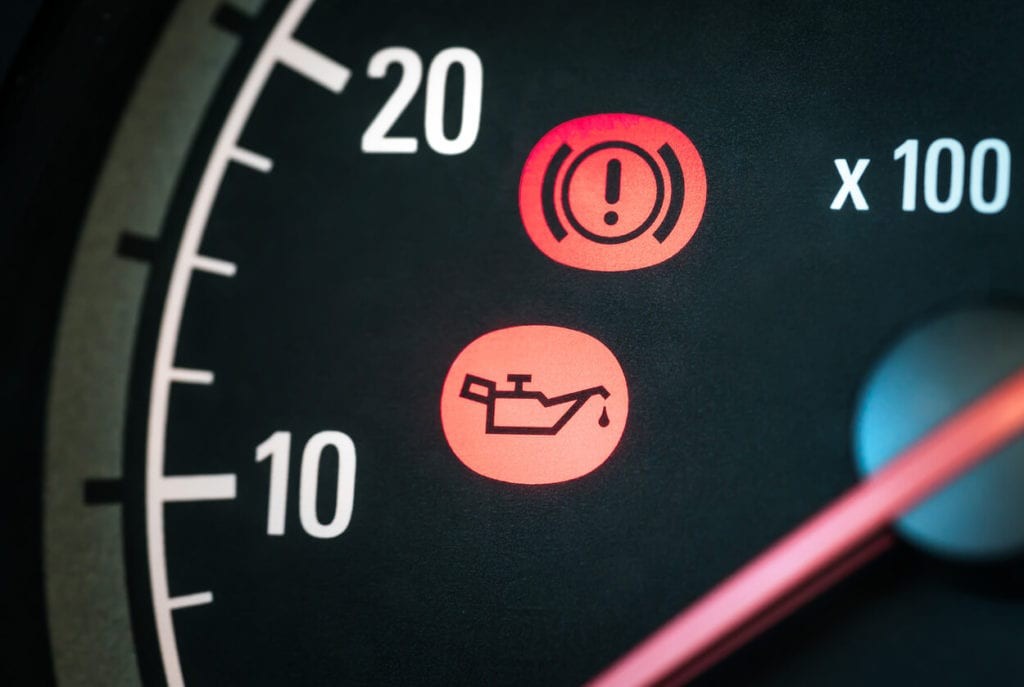Your car’s oil light is a critical warning system. It signals potential problems with your engine’s lubrication system, which can lead to severe damage if ignored. Understanding why your oil light might be flickering or turning on and off is crucial to protecting your vehicle. This article will explore the common causes of an intermittent oil light and provide solutions to address the issue.
Common Causes of a Flickering Oil Light
A consistently illuminated oil light indicates low oil pressure or low oil levels. However, an oil light that flickers on and off can be caused by several factors:
Low Oil Level
One of the most common reasons for an oil light to flicker is low oil level. When the oil level drops below a certain point, the oil pump may struggle to maintain consistent pressure, especially at idle or low speeds. This can cause the oil light to turn on and off intermittently.
 Car dashboard with oil warning light on
Car dashboard with oil warning light on
Worn Oil Pump
The oil pump is responsible for circulating oil throughout the engine. A worn-out oil pump may not be able to generate sufficient pressure consistently, leading to a flickering oil light. This is especially true at higher engine speeds when demand for oil pressure is greater.
Faulty Oil Pressure Sensor
The oil pressure sensor monitors oil pressure and triggers the warning light when pressure drops too low. A malfunctioning sensor can send inaccurate signals, causing the oil light to flicker even when oil pressure is within the normal range. Wiring issues related to the sensor can also cause intermittent problems.
Clogged Oil Filter
A clogged oil filter restricts oil flow, which can lead to pressure fluctuations and a flickering oil light. The filter’s pressure relief valve might be opening and closing intermittently trying to regulate the flow, causing the light to flicker.
Worn Engine Bearings
Worn engine bearings can cause oil pressure to drop. As bearings wear, clearances increase, allowing oil to escape more easily. This can result in fluctuating oil pressure and a flickering warning light.
Low Oil Viscosity
Using oil with the incorrect viscosity (thickness) for your engine can also contribute to oil pressure problems. Oil that is too thin may not provide adequate lubrication and pressure, particularly when the engine is hot. This can cause the light to flicker.
Engine Overheating
Excessive engine heat can thin the oil, reducing its viscosity and ability to maintain pressure. This can lead to a flickering oil light, often accompanied by other overheating symptoms.
Diagnosing and Addressing the Issue
If your oil light is flickering, it’s crucial to address the problem promptly to prevent engine damage. Here’s what you should do:
- Check the Oil Level: Immediately check your engine oil level using the dipstick. If it’s low, add oil to the recommended level.
- Inspect for Leaks: Look for oil leaks around the engine and underneath the car. Leaks can contribute to low oil levels.
- Consult a Mechanic: If the oil light continues to flicker after adding oil, it’s essential to have a qualified mechanic diagnose the problem. They can perform tests to determine the exact cause, such as checking oil pressure with a mechanical gauge, inspecting the oil pump and filter, and evaluating engine bearing wear.
Preventing Oil Light Issues
Regular maintenance is key to preventing oil light problems. Follow these tips:
- Regular Oil Changes: Change your engine oil and filter according to the manufacturer’s recommended intervals.
- Use the Correct Oil: Use the oil viscosity specified in your owner’s manual.
- Monitor Oil Level: Regularly check your engine oil level and top it off as needed.
- Address Leaks Promptly: Repair any oil leaks as soon as you notice them.
A flickering oil light is a serious warning sign. By understanding the potential causes and taking prompt action, you can protect your engine from costly damage. Don’t ignore this warning – address it immediately.